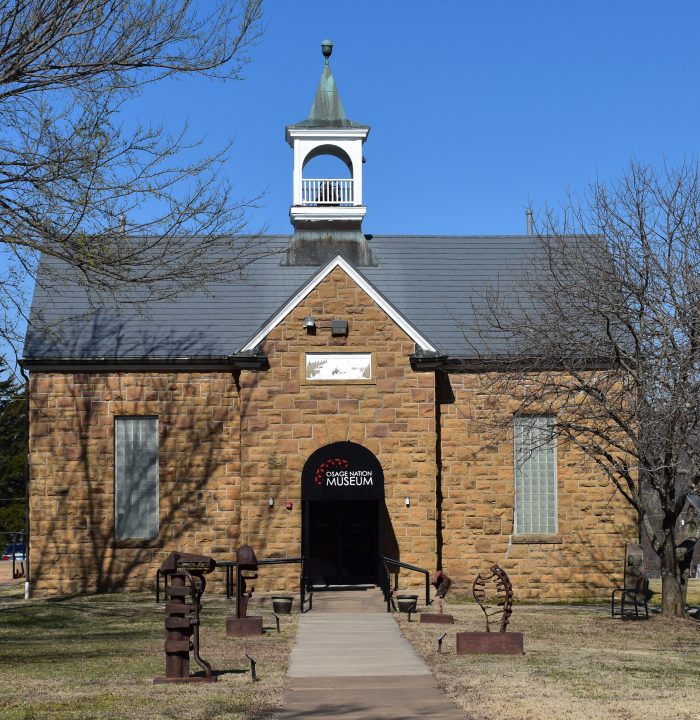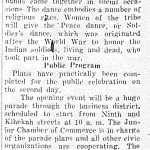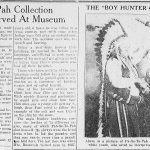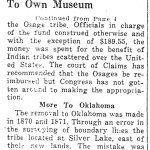April 24, 1938
The Daily Journal Capital
Microfilm Roll: MN00298

Osage Tribal Museum, Pawhuska, Oklahoma
On this day in Osage country 1938, The Daily Journal Capital published several articles pertaining to the opening of the Osage Tribal Museum.
According to the article titled, “Osages Only Tribe with Museum,” the Osage Tribal Museum was the first tribally owned museum to open in the world. The building that houses the museum was acquired by the tribe through the Works Progress Administration. Before its renovation began in 1936, the two-story building served as a chapel and a schoolhouse. Throughout renovation, however, the new building became a one story museum that was said to have seemingly doubled in space. Today the museum remains to be the oldest tribally owned museum in the United States.
Collection for the museum began fifteen years prior to its opening when the tribal council obtained John Bird’s collection of relics. John Bird, also known as Wah Shinka, a man for whom the Osages felt much affection, gathered many Indian artifacts while working in banks and at trading posts around the area. His collection included a wide variety of items including tomahawks, paintings, knives, peace pipes and more.
Another collection exhibited at the opening was that of Chief Bacon Rind, or more accurately, Wah Tze Mo In. After Bacon Rind’s death in 1932, his collection was sent to the Smithsonian Institute. However, after much persuasion, the tribal museum was able to borrow back Wah Tze Mo In’s collection as an indefinite loan. His collection contained beaded and feathered regalia, a war dance stick, eagle feathers, an Indian whistle, et cetera.
The Pah Se To Pah collection was also featured during the opening. At only twelve years old, Pah Se To Pah was in a horse racing accident that left him deaf and mute. Although tragic, his accident did not hamper his spirit. Pah Se To Pah learned Indian sign language and became known as “one of the tribe’s most colorful members” (“Pah Se To Pah Collection”). His collection was donated to the museum, as per his request, when he died of pneumonia at the age of 68. Pah Se To Pah’s collection included his turkey bone love flute, his feathered headdress, his war staff, and many other items. As stated by the museum’s first curator, Lillian Mathews, “The ultimate goal of the museum [is] to assemble everything of value in connection with Osage history” (“Osages Only Tribe”). The Museum’s first collections did not disappoint.
The opening celebrations took place on May 2-3, 1938. The public was not able to partake in the first day of celebrations, but the public was able to observe the festivities. Members of the tribe, both men and women, dressed in regalia and danced traditional Osage dances including the I’n-Lon-Schka and the Peace Dance. On May 3, the public event commenced with a grand parade consisting of numerous floats, each representing an aspect of Osage history, and military marching bands. The parade was followed by a public barbeque, several contests, including an archery contest, Indian dances, and a softball game.
Morgan M. Guzman
“Osages Only Tribe with Museum.” The Daily Journal Capital. April 24, 1938, p. 2. Microfilm roll number MN00298. Sequoyah National Research Center, Little Rock, Arkansas.
Further Reading
“Chief Bacon Rind’s Collection Shown.” The Daily Journal Capital. April 24, 1938, p. 9. Microfilm roll number MN00298. Sequoyah National Research Center, Little Rock, AR.
“Early Trader Began Collection.” The Daily Journal Capital. April 24, 1938, p. 5. Microfilm roll number MN00298. Sequoyah National Research Center, Little Rock, AR.
“Osage Tribal Museum.” The Osage Nation. https://www.osagenation-nsn.gov/museum. Accessed February 19, 2018.
”Pah Se To Pah Collection to be Preserved at Museum.” The Daily Journal Capital. April 24, 1938, p. 10. Microfilm roll number MN00298. Sequoyah National Research Center, Little Rock, AR.
“Plans Ready for Museum Celebration.” The Daily Journal Capital. April 29, 1938, p. 1. Microfilm roll number MN00298. Sequoyah National Research Center, Little Rock, AR.
Source File(s)
Related Stories
- Colorful Indian Figure Passes On Here Tuesday
- George BaconRind
- Osages Begin Dances Today in Advance of Oct. 14 Celebration
- Universal Sign Language gives Indian Opportunity to Tell Old Stories Here






